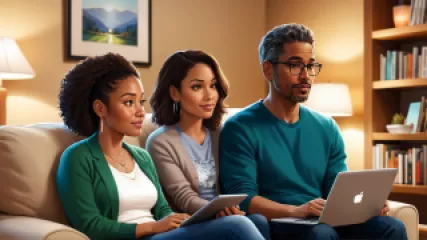How Online Couples Therapy Sessions Helped Us Resolve Conflicts
Our journey through relationship conflict and therapy began as a typical love story. My name is Hazel Graham, and I’m here to share how online couples therapy sessions helped us resolve conflicts that once seemed insurmountable. If you're struggling in your relationship, I hope our experience offers you some comfort and guidance.
The Early Days of Our Relationship
Sean and I met in college, and our connection was instant. From late-night study sessions to impromptu weekend getaways, we were inseparable. Those early days were filled with excitement and new experiences. Like many young couples, we believed our love was invincible.
However, as time went by, the euphoria of newfound love started to wane, and real-life challenges set in. We graduated, found jobs, and moved in together. The routine of daily life began to expose cracks in our seemingly perfect relationship. Arguments became more frequent, and unresolved conflicts started accumulating like clutter in a neglected attic.
The Turning Point
The turning point came one evening after a particularly heated argument. Sean and I sat on opposite ends of the couch, exhausted and emotionally drained. We both realized that something had to change. Traditional couples therapy was our first thought, but the logistics of scheduling and attending in-person sessions felt overwhelming. That’s when we stumbled upon the concept of virtual relationship therapy.
Intrigued by the idea of resolving conflicts from the comfort of our home, we decided to give virtual couples counseling a try. It seemed like a convenient and less intimidating way to address our issues. Little did we know, it would become a transformative experience for us.
Starting Online Couples Therapy
Our first step was finding a reputable therapist who offered online sessions. After some research, we found Dr. Alondra Frazier, a licensed clinical psychologist specializing in relationship conflict therapy. Her profile resonated with us, and we felt hopeful about starting this new chapter.
The initial consultation was straightforward. Dr. Frazier explained how virtual couples counseling worked and what we could expect from the sessions. She emphasized the importance of commitment and honesty throughout the process. With her guidance, we scheduled our first official session.
The convenience of online therapy was immediately apparent. Without the need to commute or adjust our schedules drastically, we felt more at ease. It was reassuring to know that we could access professional help without stepping outside our comfort zone.
Exploring Our Issues
During our first few sessions, Dr. Frazier guided us through a series of exercises to identify the root causes of our conflicts. We discussed our communication patterns, individual stressors, and unresolved past issues that were affecting our relationship. It was eye-opening to see how deeply entrenched some of these problems were.
One significant revelation was our differing communication styles. While Sean preferred direct and straightforward conversations, I often relied on subtle hints and non-verbal cues. This mismatch led to frequent misunderstandings and frustration. Recognizing this discrepancy was the first step towards improving our interactions.
Effective Communication Techniques
Dr. Frazier introduced us to several communication techniques that proved invaluable. One such technique was "active listening." It involved fully focusing on the speaker, understanding their message, and responding thoughtfully rather than reactively. This practice helped us break the cycle of defensive arguments and fostered a more empathetic dialogue.
Another useful tool was the "I" statement. Instead of blaming each other, we learned to express our feelings and needs using statements like "I feel hurt when..." or "I need support with..." This approach minimized defensiveness and encouraged mutual understanding.
Managing Stress and External Factors
As we delved deeper into our therapy sessions, we discovered that external stressors significantly impacted our relationship. Work pressures, financial concerns, and family dynamics all played a role in escalating our conflicts. Dr. Frazier helped us develop strategies to manage these stressors more effectively.
One such strategy was setting boundaries. We learned to establish clear boundaries between work and personal life, ensuring that our time together remained sacred and undisturbed. This simple yet powerful change brought a sense of balance and harmony to our relationship.
Additionally, we explored mindfulness practices to reduce stress and enhance our emotional well-being. Activities like meditation, deep breathing exercises, and journaling became part of our daily routine. These practices not only helped us individually but also strengthened our bond as a couple.
Rebuilding Trust and Intimacy
Trust and intimacy are the cornerstones of any healthy relationship. Over time, our conflicts had eroded these essential elements, leaving us feeling disconnected and distant. Rebuilding trust required patience, vulnerability, and consistent effort.
Dr. Frazier introduced us to trust-building exercises designed to foster emotional intimacy. One exercise involved sharing our deepest fears, dreams, and insecurities with each other. It was a profoundly vulnerable experience, but it allowed us to see each other in a new light and rekindle our emotional connection.
We also worked on physical intimacy, which had taken a backseat amidst our conflicts. Simple gestures like holding hands, hugging, and spending quality time together helped reignite the spark in our relationship. These small acts of affection reminded us of the love and affection we still had for each other.
The Role of Accountability
Accountability played a crucial role in our therapy journey. Dr. Frazier encouraged us to take responsibility for our actions and acknowledge our contributions to the conflicts. This shift in perspective was challenging but necessary for genuine growth.
We started keeping a journal of our thoughts and feelings, documenting instances where we fell back into old patterns or made progress. Reviewing these entries during our sessions provided valuable insights and highlighted areas that needed further work.
Dr. Frazier also emphasized the importance of celebrating small victories. Whether it was resolving a minor disagreement or successfully implementing a new communication technique, acknowledging our progress motivated us to keep moving forward.
Navigating Setbacks
Our journey through virtual relationship therapy wasn't without setbacks. There were moments when old habits resurfaced, and conflicts seemed insurmountable. However, Dr. Frazier's guidance and our commitment to the process kept us grounded.
We learned that setbacks were a natural part of the healing process. Instead of viewing them as failures, we saw them as opportunities for growth. Each setback taught us valuable lessons about ourselves and our relationship, reinforcing the importance of perseverance.
Support System and Self-Care
Throughout our therapy journey, we realized the significance of having a support system. Friends, family, and even online communities provided encouragement and validation. Sharing our experiences with others going through similar challenges made us feel less isolated and more understood.
Self-care also became a priority. Taking care of our physical, emotional, and mental well-being was essential for maintaining a healthy relationship. Simple activities like exercising, pursuing hobbies, and spending time in nature rejuvenated us and strengthened our resilience.
The Impact of Virtual Couples Counseling
As our therapy sessions progressed, the positive changes in our relationship became evident. Conflicts that once seemed insurmountable were now approached with empathy and understanding. We developed a deeper appreciation for each other's perspectives and learned to navigate disagreements constructively.
Virtual couples counseling provided us with the tools and insights needed to transform our relationship. The convenience and accessibility of online sessions allowed us to prioritize our relationship without compromising our daily responsibilities.
Moreover, the skills we acquired during therapy extended beyond our relationship. Improved communication, stress management, and emotional resilience positively impacted other aspects of our lives, including work and personal relationships.
Looking Ahead
Our journey through online couples therapy was a testament to the power of commitment, vulnerability, and professional guidance. While we still face challenges, we now have the tools and confidence to navigate them together.
If you're considering virtual relationship therapy, I encourage you to take that step. It's a journey of self-discovery and growth that can lead to a stronger, more fulfilling relationship. Remember, seeking help is not a sign of weakness but a courageous act of love and dedication.
As Sean and I continue to build our future together, we carry with us the lessons learned and the bond strengthened through therapy. Our story is a reminder that even the most challenging conflicts can be resolved with the right support and a willingness to grow.
Final Thoughts
Online couples therapy has revolutionized the way we approach relationship conflicts. The convenience, accessibility, and effectiveness of virtual sessions make it a viable option for couples seeking to improve their relationships.
Our experience with Dr. Frazier and virtual relationship therapy has been transformative. It taught us the importance of effective communication, emotional intimacy, and accountability. Most importantly, it reminded us that love is a journey that requires continuous effort and growth.
If you find yourself struggling in your relationship, know that help is available. Virtual couples counseling can provide the support and guidance needed to navigate conflicts and build a stronger, healthier relationship. Embrace the journey, and remember that every step forward is a step towards a brighter future together.






